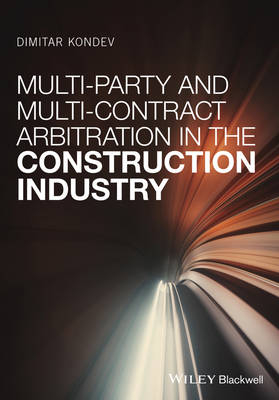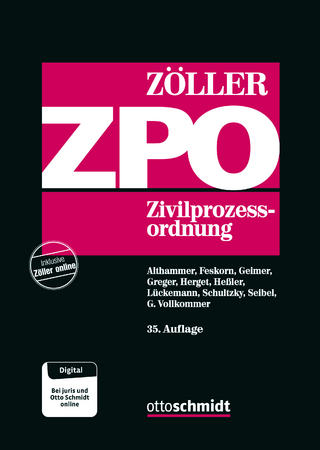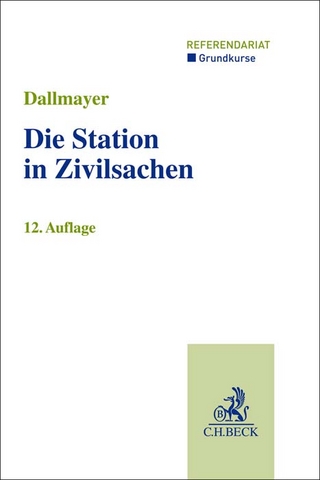
Multi-Party and Multi-Contract Arbitration in the Construction Industry
Wiley-Blackwell (Verlag)
978-1-119-25172-9 (ISBN)
- Titel z.Zt. nicht lieferbar
- Versandkostenfrei innerhalb Deutschlands
- Auch auf Rechnung
- Verfügbarkeit in der Filiale vor Ort prüfen
- Artikel merken
Highly practical in approach, the detailed interpretation and assessment of the arbitration of multi-party disputes will facilitate understanding and decision making by arbitrators, clients and construction contractors.
Dimitar Kondev, Mag. Jur., LL.M. Ph.D. in Law, MCIArb, MIR, is a lawyer specializing in construction law and dispute resolution. He is an Associate in the International Arbitration Group of White & Case in Paris and a lecturer in International Construction Law at the Aarhus University, Denmark. His practice includes construction law in general, construction disputes and international commercial arbitration. He has experience in various sectors, including commercial development, energy and infrastructure. Dimitar has authored several articles published in the International Construction Law Review, Construction Law International and other journals. He is registered as dispute adjudicator under the Bulgarian list of FIDIC dispute adjudication experts (BACEA National List).
About the Author x
Foreword xi
Preface xiii
Acknowledgements xv
List of Abbreviations xvi
1 Introduction 1
1.1 General background and research problem 1
1.2 Scope of the book, limitations and literature review 4
1.2.1 Scope of the book 4
1.2.2 Limitations 4
1.2.3 Literature review 5
1.3 Sources used 6
1.4 Structure of the book 9
1.5 Aims and contribution of the book 10
2 Multi‐Party Arbitration in General 11
2.1 Terminology notes 11
2.1.1 Definition of multi‐party arbitration 11
2.1.2 Multi‐party and multi‐contract arbitration: divergent or similar concepts? 12
2.1.3 Group of contracts doctrine 14
2.2 Legal techniques introducing multi‐party arbitration 15
2.2.1 Single request for arbitration 16
2.2.2 Joinder 16
2.2.3 Intervention 16
2.2.4 Consolidation 17
2.3 Advantages of multi‐party arbitration 18
2.3.1 Avoids risk of inconsistent findings 18
2.3.2 Less time and fewer costs 19
2.3.3 Fewer factual errors 20
2.4 Obstacles to multi‐party arbitration 21
2.4.1 Consensual nature of arbitration 21
2.4.2 Arbitration as a two‐party setup 23
2.4.3 Arbitration as a confidential process 24
2.4.4 Setting aside proceedings and non‐recognition and / or non‐enforcement of arbitral awards 26
2.4.5 Practical difficulties 30
3 The Need for Multi‐Party Arbitration in the Construction Sector 31
3.1 Specifics of construction disputes and construction arbitration 31
3.2 Introduction to international standard form construction agreements 33
3.2.1 FIDIC Conditions of Contract 33
3.2.2 NEC contracts 36
3.2.3 ICC contracts 37
3.2.4 ENAA model forms 38
3.2.5 IChemE contracts 39
3.2.6 PPC International and SPC International 39
3.3 Contractual structures in construction projects 40
3.3.1 ‘Build‐only’ projects 40
3.3.2 ‘Design‐build’ or ‘turnkey’ projects 41
3.3.3 Construction management 43
3.3.4 Management contracting 44
3.3.5 ‘Design‐build‐operate’ (‘DBO’) model 45
3.3.6 Partnering and alliancing 46
3.4 Parties’ interests in multi‐party arbitration 46
3.4.1 Employer 46
3.4.2 Contractor 51
3.4.3 Subcontractor 52
3.4.4 Designer 53
3.4.5 Engineer 54
3.4.6 Suppliers 56
3.4.7 Technical consultants 56
3.4.8 Guarantors 56
3.4.9 Concluding remarks 58
4 Multi‐Party Arbitration Solutions under Arbitration Rules 60
4.1 ICC Rules 61
4.1.1 Multi‐contract claims and prima facie assessment 62
4.1.2 Joinder 67
4.1.3 Consolidation 69
4.2 CEPANI Rules 71
4.2.1 Multiple parties and multi‐contract claims 71
4.2.2 Joinder and intervention 73
4.2.3 Consolidation 75
4.3 LCIA Rules 77
4.4 UNCITRAL Rules 80
4.5 Swiss Rules 84
4.5.1 Prima facie test 84
4.5.2 Consolidation 84
4.5.3 Joinder and intervention 88
4.6 Rules adopted by the American Arbitration Association (‘AAA’) 90
4.6.1 Construction Industry Arbitration Rules (‘CIAR’) 90
4.6.2 ICDR Rules 92
4.7 Vienna Rules 94
4.7.1 Joinder 95
4.7.2 Consolidation 98
4.8 DIS Arbitration Rules 99
4.9 SCC Rules 100
4.10 DIA Rules 101
4.11 Arbitration rules in Asia 102
4.11.1 CIETAC Rules 102
4.11.2 SIAC Rules 106
4.11.3 HKIAC Rules 109
4.11.4 JCAA Rules 114
4.12 Concluding remarks regarding arbitration rules 115
5 Multi‐Party Arbitration Solutions under Arbitration Laws 121
5.1 UNCITRAL Model Law 122
5.2 The United Kingdom 124
5.3 The Netherlands 129
5.4 Belgium 131
5.5 New Zealand 132
5.6 Hong Kong 133
5.7 Canada 137
5.8 Australia 138
5.9 Other countries 139
5.10 Multi‐party arbitration in the United States 140
5.10.1 Legal framework 140
5.10.2 United States’ case law on multi‐party arbitration 146
5.11 Should arbitration laws deal with multi‐party arbitration? 158
5.12 Concluding remarks regarding arbitration laws 164
6 Contractual Solutions to Multi‐Party Arbitration 167
6.1 FIDIC Conditions of Contract 169
6.2 Blue Form 175
6.2.1 Clause 18(2) of the 1984 Blue Form 175
6.2.2 Use of the Blue Form in conjunction with the FIDIC Conditions of Contract 183
6.2.3 Commentary on clause 18(2) 189
6.2.4 Clause 18(8) of the 1991 Blue Form 201
6.2.5 Clause 18(10) of the 1998 Blue Form 205
6.2.6 Clause 18C(4) of the 2008 Blue Form 206
6.3 JCT Contracts 208
6.3.1 JCT 80 approach to multi‐party arbitration 209
6.3.2 Commentary on the JCT 80 approach 219
6.3.3 New JCT approach 222
6.4 ACA standard forms 223
6.5 Nec3 226
6.5.1 Main contract provisions 227
6.5.2 Subcontract provisions 229
6.5.3 Do NEC3 provisions create a self‐contained mechanism for joint adjudication? 230
6.5.4 Compatibility between the joint adjudication provisions and the dispute notification requirements 232
6.6 IChemE contracts 234
6.7 ICC contracts 237
6.8 PPC and SPC International 238
6.9 ENAA Model forms 240
6.10 AIA standard forms 242
6.11 ConsensusDocs 247
6.12 AB 92 and ABT 93 250
6.13 Concluding remarks regarding contractual approaches 252
7 Proposed Solutions 255
7.1 Jurisdictional approach 256
7.2 Abstract consensual approach 262
7.3 Proposed contractual solutions 264
7.3.1 IBA guidelines for Drafting International Arbitration Clauses 267
7.3.2 AAA Guide to Drafting Alternative Dispute Resolution Clauses for Construction Contracts 271
7.3.3 Drafting Multi‐Party Arbitration Clauses 273
7.3.4 Sample multi‐party arbitration clause 303
7.4 Institutional approach 313
7.4.1 How to create a workable multi‐party arbitration mechanism under arbitration rules? 315
7.4.2 Compatibility of arbitration agreements 319
7.4.3 Other circumstances 322
8 Conclusion 325
Table 1 Summary of Multi-Party Arbitration Provisions under the Reviewed Arbitration Rules 328
Table 2 Summary of Multi-Party Arbitration Provisions under Arbitration Laws 333
Appendix 1 Second Alternative Clause of Clause 20 of the FIDIC Subcontract 337
Appendix 2 Multi‐Party Arbitration Provisions under the Blue Form 351
Appendix 3 Multi‐Party Arbitration Clauses under the ENAA Model Form – International Contract for Process Plant Construction, 2010 and Related Subcontracts 355
Bibliography 358
Index 381
| Erscheinungsdatum | 19.03.2017 |
|---|---|
| Verlagsort | Hoboken |
| Sprache | englisch |
| Maße | 173 x 246 mm |
| Gewicht | 953 g |
| Themenwelt | Recht / Steuern ► EU / Internationales Recht |
| Recht / Steuern ► Privatrecht / Bürgerliches Recht ► Zivilverfahrensrecht | |
| Technik ► Bauwesen | |
| ISBN-10 | 1-119-25172-9 / 1119251729 |
| ISBN-13 | 978-1-119-25172-9 / 9781119251729 |
| Zustand | Neuware |
| Haben Sie eine Frage zum Produkt? |
aus dem Bereich


